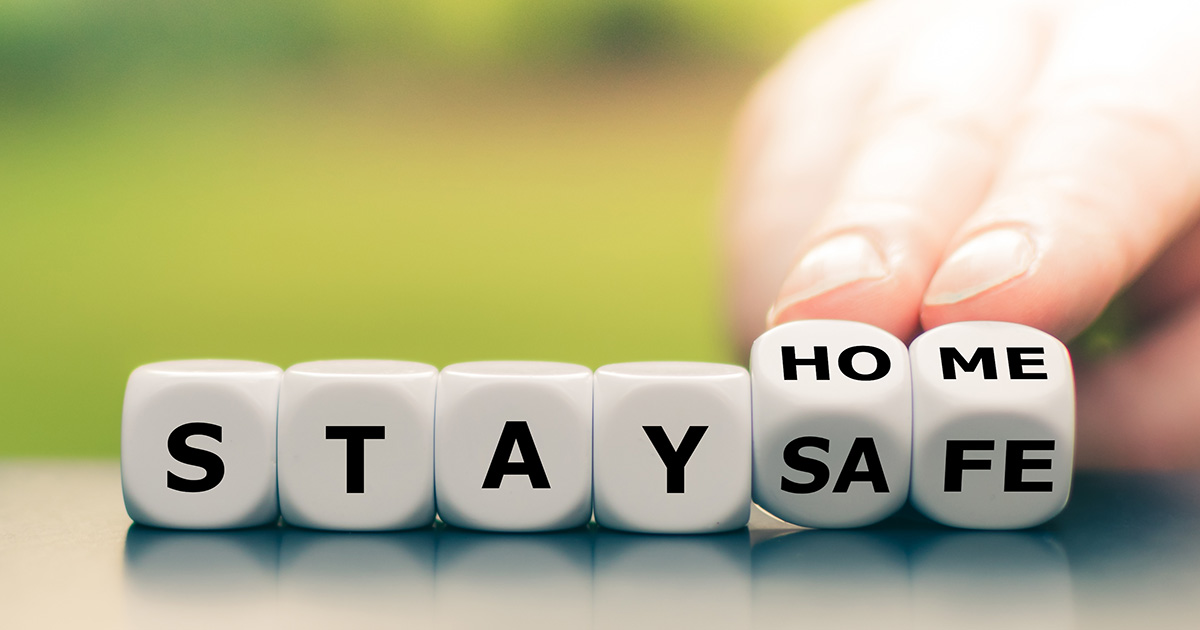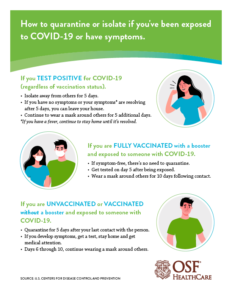
What you should know about quarantine
Today, we focus on when to quarantine versus isolation.
We’ll help you understand when to do which and for how long.
What is quarantine vs. isolation?
By definition, quarantine is a place or a period of time where people who have been exposed to an infectious or contagious disease avoid physical contact with others. Quarantine also can apply to people who might have been exposed, or to travelers arriving from another location.
The Centers for Disease Control and Prevention (CDC) draws a slight, but important, distinction between quarantine and isolation.
“The CDC definition is used to keep someone who might have been exposed to COVID-19 away from others. Isolation is used to keep people whom we know are infected away from healthy people,” said Ralph Velazquez, MD, chief medical officer for OSF HealthCare.
When should you quarantine?
The straightforward answer is – it really depends on your vaccination status and whether you’re experiencing symptoms following close contact with someone who has tested positive for COVID-19.
If you have been in close contact with someone who tests positive and you are not vaccinated, you should quarantine immediately for five days.
You should get a test on day five. If your test is negative and you are free of symptoms after day five, you can leave your home but you must mask around others for five more days. This also is true if you’ve been vaccinated and qualify for a booster, but haven’t yet received the booster.
If you are vaccinated, have received a booster and are symptom free, there is no need to quarantine. However, you should get a test on day five following your exposure and wear a mask around others – indoor and outdoor – for 10 days.
As for isolation, if you test positive for COVID-19, everyone – regardless of vaccination status – should stay home for five days. If you have no symptoms after five days, you can leave your house. Continue wearing a mask around others for five additional days.
What is close contact?
“We’re talking two primary factors: time and proximity,” Dr. Velazquez said. “We define close contact as being within six feet of someone for a total of 15 minutes or more within a 24-hour period. The 15 minutes can be all at one time, or they can be cumulative, compiled over multiple encounters within the 24-hour period.
Indoor contact carries a greater risk than outdoor. The risk of indoor venues can vary, depending on the size of the room, the number of people and the quality of ventilation. Or perhaps you have only a brief encounter, but there’s physical contact. Hugs and kisses are close contact. So is providing care to someone who is sick with COVID-19.
And there can be quirky considerations.
“If you go to a gathering and someone across the room has COVID-19, you might think you have less risk,” Dr. Velazquez said. “But here’s where it gets tricky. I didn’t go near that person, but I was close to someone who was hugging them and spent 15 minutes with them earlier. I have to consider that potential.
“It’s pretty consistent, what we’re finding out now. The virus is being spread when people let down their guard.”
Updated Guidelines
In December 2021, the CDC issued durations in certain circumstances.
The change is the result of science demonstrating that the majority of COVID-19 transmission occurs early in the course of illness, generally in one or two days prior to the onset of symptoms and the 2-3 days after.
Therefore, people who test positive should isolate for five days and, if they are symptom free at that time, they may leave isolation and continue to mask for five days to minimize the risk of infecting others.
Should you get tested in quarantine?
Unless ordered to be tested, the decision is yours. But be careful about testing too early. And be aware that you can test negative today and positive tomorrow.
In the revised guidelines by the CDC, the agency recommends getting tested – if possible – on day five following exposure to a close contact.
Why should you quarantine?
Quarantines have a long history and have proven an effective method of infection control.
“As much as we resist lockdowns and don’t want to impose on individual freedom, lockdowns work,” Dr. Velazquez said.
“So if you come in contact with anyone who has COVID-19, do something known to work. Quarantine yourself, if applicable. Stay away from other people. It’s OK to go into your yard; staying home also includes being outdoors, and the fresh air and sunlight are good for you. But avoid contact with other people. That’s the key.”
And when free from quarantine or from isolating, continue to take precautions to prevent the spread of the virus. This includes wearing a mask, washing your hands frequently and maintaining a physical distance from others when possible.
